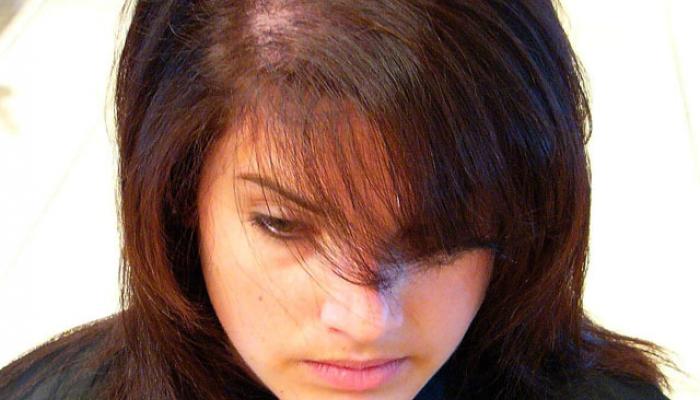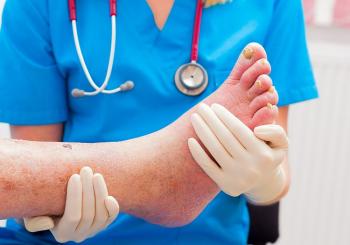
Alopecia areata is a skin disorder that causes hair loss, usually in patches, most often on the scalp. Usually, the bald patches appear suddenly and affect only a limited area. The hair grows back within 12 months or less. For some people, however, the problem can last longer and be more severe, causing total baldness (alopecia totalis) or total loss of body hair (alopecia universalis).
The cause of alopecia areata is probably an autoimmune reaction. This means the body's immune system incorrectly attacks the body's own cells. In the case of alopecia areata, the cells under attack are in the hair follicles (structures that grow hair), especially follicles within the scalp. Genetic (inherited) factors may play a role, too, particularly when the disorder strikes those under age 30. Almost 40% of people younger than age 30 with alopecia areata have at least one family member who has been diagnosed with the same disorder. The risk of developing alopecia areata is unusually high in people who have asthma, hay fever, thyroid disease, vitiligo (a condition in which patches of skin lose their color), pernicious anemia and Down syndrome. Although experts once believed episodes of alopecia areata could be triggered by stress, newer research has failed to prove that stress is a factor. About 60% of people with alopecia areata experience the first episode of hair loss before age 20. It is usually followed by hair regrowth. However, it's common for the problem to come back. New bald patches can develop at the same time older ones are regrowing hair.
Symptoms
In its most common form, alopecia areata causes small round or oval patches of baldness on the scalp. The area of bald skin looks smooth and normal. In most cases, there are no other scalp symptoms. Occasionally, there is mild itching, tingling, tenderness or a burning sensation in the affected area. Some people with alopecia areata also have abnormalities in the surface of their fingernails, such as tiny pits or dents, grooves, superficial splitting, or an abnormal area of redness. In rarer, more severe forms of the disorder, hair loss can involve the entire scalp or the entire body, including the eyebrows, eyelashes, beard, underarm hair and pubic hair (hair around the genitals).
Diagnosis
Your doctor will usually be able to diagnose alopecia areata based on examination of the areas of your hair loss and your symptoms. To look for further evidence, your doctor may pull gently on the hairs near the edge of the bald area to determine whether these hairs come out very easily and to inspect them for any structural abnormalities of the root or shaft. If there is still doubt as to diagnosis, a small skin biopsy of your scalp may confirm the diagnosis. In a biopsy, a small piece of skin is removed and examined in a laboratory.
Expected Duration
In most small patches of alopecia areata, the hair regrows within 6 to 12 months. However, it's common for the problem to happen again.
Prevention
Alopecia areata cannot be prevented.
Treatment
Although there is no permanent cure for alopecia areata, there are ways that may short-circuit the body's autoimmune reaction in the scalp and encourage hair regrowth. For limited areas of alopecia, the most effective initial therapy is a series of corticosteroid injections into the bald patches to suppress the immune reaction.
Some people with the condition will respond to high dose topical preparations applied to the affected areas.
Many other therapies can be tried if corticosteroids have not provided the desired improvements. Examples include a short course of oral corticosteroids and immunotherapy. Also topical minoxidil may increase hair growth by accelerating the speed of the natural hair cycle and increasing the diameter of hairs that begin to grow.
Your treatment depends on several factors, including your age (some treatments are only for adults), the amount of your hair loss, and your willingness to deal with any treatment-related discomfort or side effects.
If you have mild hair loss, you may choose to simply modify your hairstyle or wear a hairpiece until the bald area fills in.
If you lost a large amount of hair on your scalp, you may choose to wear a wig or hairpiece until your treatment starts to work. If you have an obvious loss of eyebrow hair, you may choose to have injections of tiny dots of colored pigments into the eyebrow area (a procedure called dermatography). If you find it hard to cope with the change in your appearance, mention this to your doctor or seek advice from a mental health professional.
When To Call a Professional
Make an appointment to see your doctor if:
- You suddenly develop a bald spot on your scalp
- Your hair stylist tells you that your hair is thinning, or that you have small bald areas
- You have lost your eyebrows or eyelashes, your beard is thinning, or you have noticeably less hair on your underarms or pubic area
Prognosis
In more than 90% of cases, hair grows back and fills the bald spot within one year, even without treatment. However, recurrences are common, and most people have several episodes of the disorder during a lifetime. Despite treatment, about 7% of people experience prolonged large areas of hair loss with little hair regrowth.
For consultation with doctor follow the link https://medhelp24.com/ru/users/advanced-hair-clinics-hair-transplant-hair-restoration-clinic#profile-doctor




